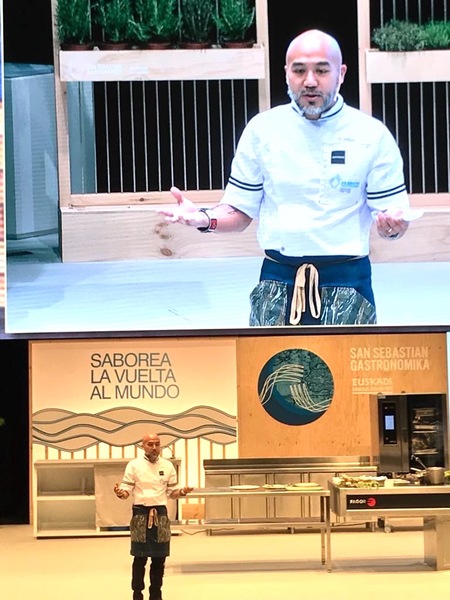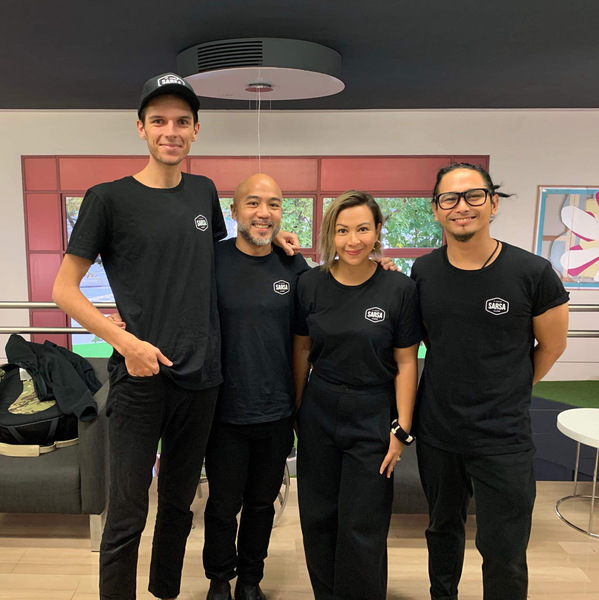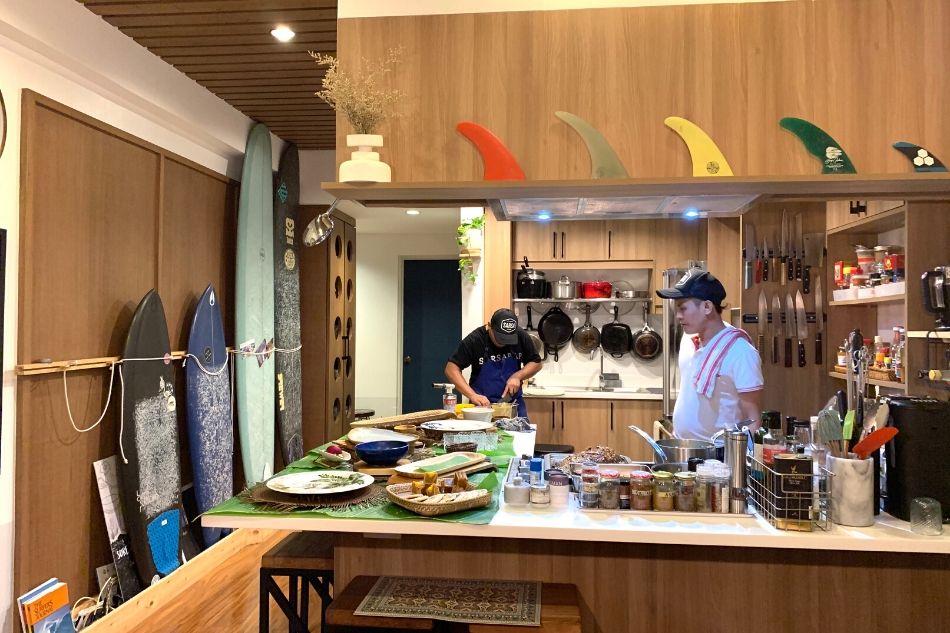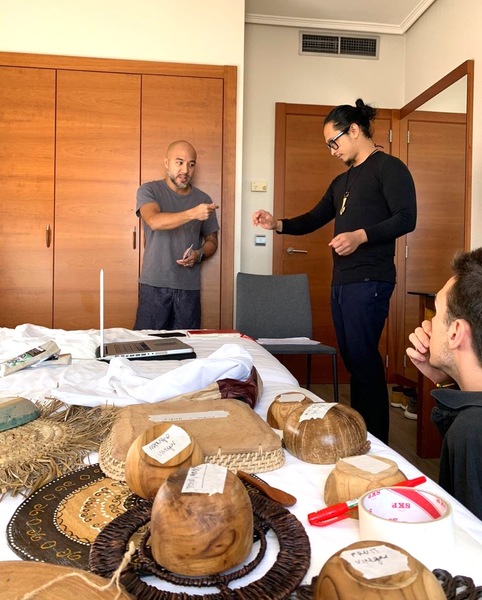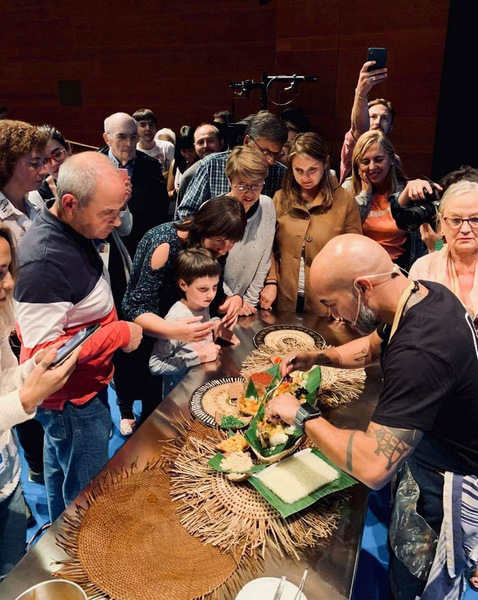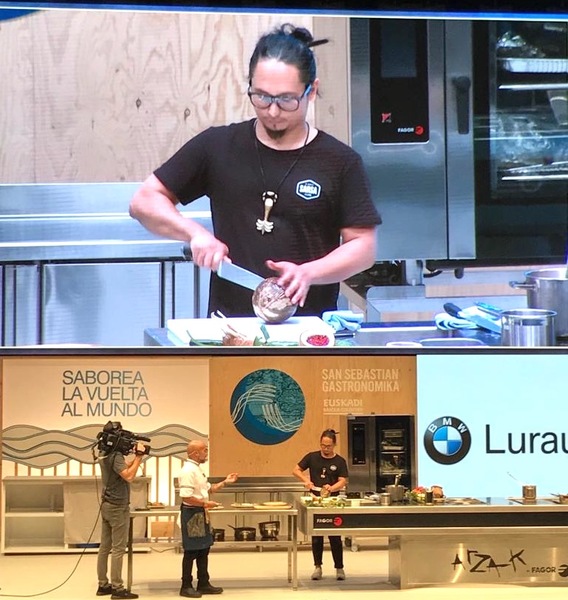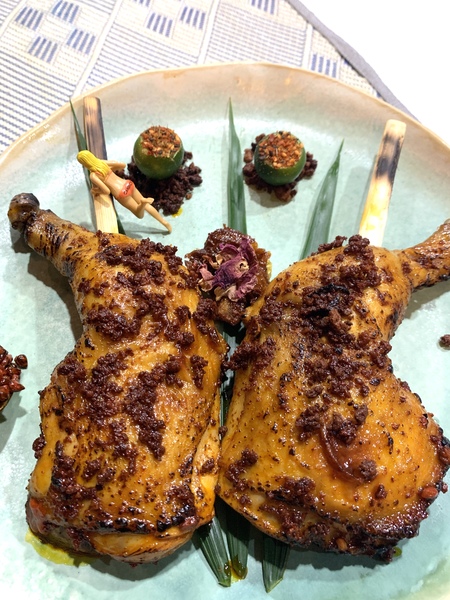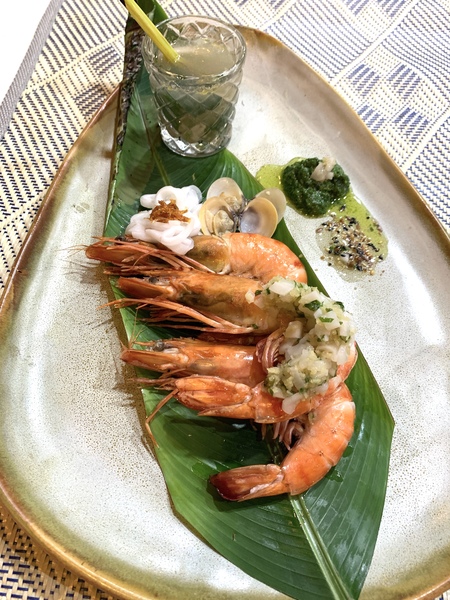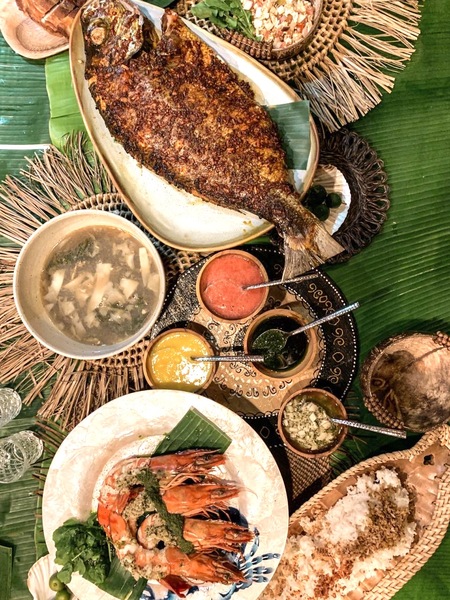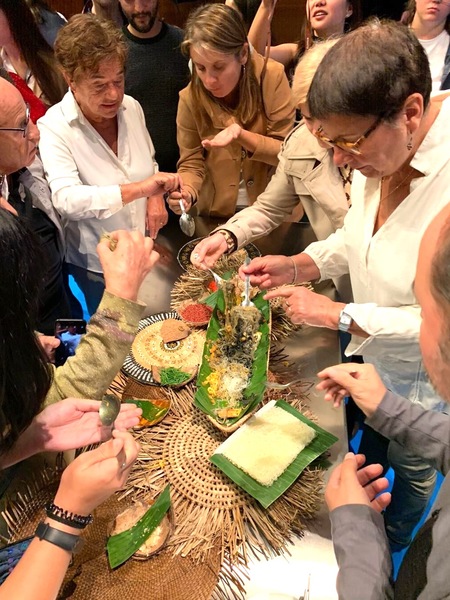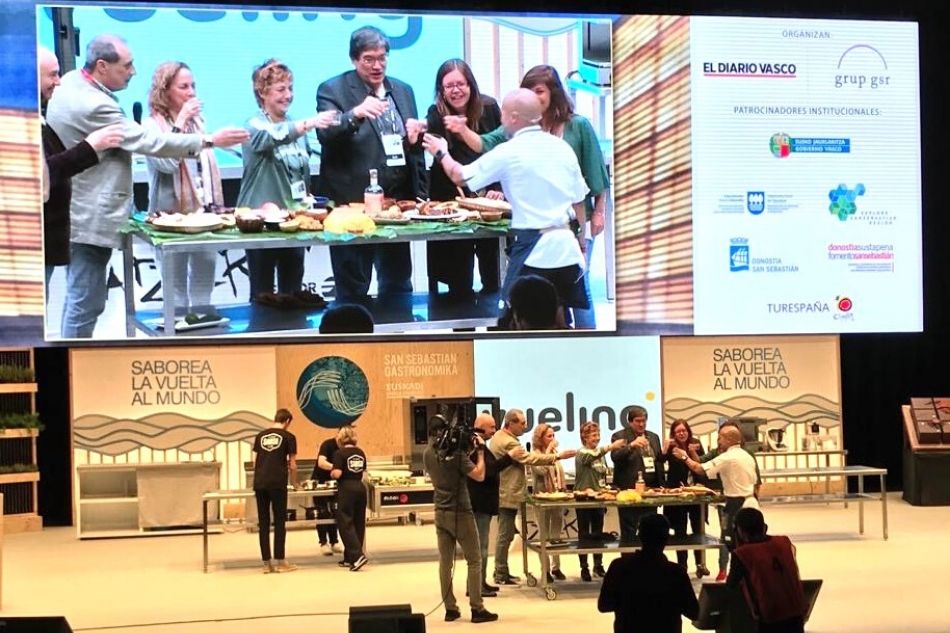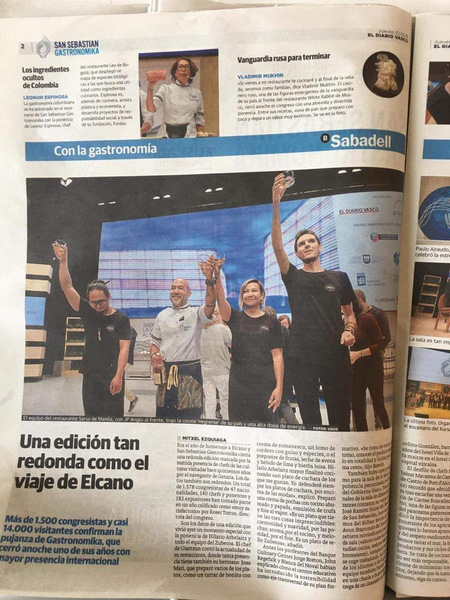Chef JP Anglo brought inasal, binakol, and a boodle fight to the bastion of Spanish cuisine
ADVERTISEMENT

Welcome, Kapamilya! We use cookies to improve your browsing experience. Continuing to use this site means you agree to our use of cookies. Tell me more!
Chef JP Anglo brought inasal, binakol, and a boodle fight to the bastion of Spanish cuisine
ANCX
Published Nov 03, 2019 11:49 AM PHT
|
Updated Nov 04, 2019 11:20 AM PHT
JP Anglo is one of those chefs who seem to be everywhere. He is busy running five branches of Sarsa Kitchen + Bar that serves his take on Filipino, and especially Visayan food. His newly married life, love of surfing, and the beach lifestyle are splashed on his Instagram account @chefjayps, with more than 150,000 followers. Earlier this year, he traveled to Los Angeles to collaborate with acclaimed Fil-Am chefs Tom Cunanan of Bad Saint and Charles Olalia of Ma’am Sir, and then to Singapore to cook Filipino with Chef Malcolm Lee in one Michelin-starred Candlenut. The latest feather on his cap was his participation at the San Sebastian Gastronomika just this October, as one of only two Filipino presenters, the other being Chef Sau del Rosario. Another presenter with a Filipino connection was Chef Christina Sunae, with Korean-American roots, but who grew up in Pampanga and now cooks in Argentina.
JP Anglo is one of those chefs who seem to be everywhere. He is busy running five branches of Sarsa Kitchen + Bar that serves his take on Filipino, and especially Visayan food. His newly married life, love of surfing, and the beach lifestyle are splashed on his Instagram account @chefjayps, with more than 150,000 followers. Earlier this year, he traveled to Los Angeles to collaborate with acclaimed Fil-Am chefs Tom Cunanan of Bad Saint and Charles Olalia of Ma’am Sir, and then to Singapore to cook Filipino with Chef Malcolm Lee in one Michelin-starred Candlenut. The latest feather on his cap was his participation at the San Sebastian Gastronomika just this October, as one of only two Filipino presenters, the other being Chef Sau del Rosario. Another presenter with a Filipino connection was Chef Christina Sunae, with Korean-American roots, but who grew up in Pampanga and now cooks in Argentina.
You may also like:
You may also like:
- Chef Tatung returns to his Quezon City ‘hood with a restaurant brimming with nostalgia
- Gilda Cordero Fernando may be wheelchair bound, but her creative spirit is as free as ever
- “You’ll never grow hungry in Tondo:” Where to eat in Mayor Isko’s ‘hood, an expert’s guide
- At the San Sebastian Gastronomika, why the Basque Country is a food destination like no other
- Chef Tatung returns to his Quezon City ‘hood with a restaurant brimming with nostalgia
- Gilda Cordero Fernando may be wheelchair bound, but her creative spirit is as free as ever
- “You’ll never grow hungry in Tondo:” Where to eat in Mayor Isko’s ‘hood, an expert’s guide
- At the San Sebastian Gastronomika, why the Basque Country is a food destination like no other
The Gastronomika is a much respected culinary event held every October in the city of San Sebastian in Spain’s Basque Country. It is a gathering of the world’s top chefs and culinary practitioners where the most forward thinking culinary trends and ideas are shared and disseminated. This year, the Gastronomika celebrated the 500th anniversary of Basque native Juan Sebastian Elkano’s circumnavigation of the world, as the navigator in Ferdinand Magellan’s historic expedition. Since the Philippines was one of the regions visited by Elkano, the organizers invited Anglo and del Rosario, the first time Filipinos have presented onstage.
The Gastronomika is a much respected culinary event held every October in the city of San Sebastian in Spain’s Basque Country. It is a gathering of the world’s top chefs and culinary practitioners where the most forward thinking culinary trends and ideas are shared and disseminated. This year, the Gastronomika celebrated the 500th anniversary of Basque native Juan Sebastian Elkano’s circumnavigation of the world, as the navigator in Ferdinand Magellan’s historic expedition. Since the Philippines was one of the regions visited by Elkano, the organizers invited Anglo and del Rosario, the first time Filipinos have presented onstage.
Anglo took to the stage on October 8, the third day of this four-day event, at the Kursaal Congress Centre in San Sebastian. His presentation celebrated his Negrense roots, his love for his country and its terrain, and his passion for local ingredients. Here’s what he recounted to ANCX about this memorable experience:
Anglo took to the stage on October 8, the third day of this four-day event, at the Kursaal Congress Centre in San Sebastian. His presentation celebrated his Negrense roots, his love for his country and its terrain, and his passion for local ingredients. Here’s what he recounted to ANCX about this memorable experience:
ADVERTISEMENT
The invitation
The invitation
Chef Chele Gonzalez (of Gallery by Chele) sent me a message, “JP, they’re trying to reach you.” The organizers of the Gastronomika had invited Joel Binamira first but he turned it down. Chele said, “Joel turned it down because he said, ‘I’m not going to cook in front of those chefs. I’m no chef.’” So why me? I don’t know, but the connection I think was Madrid Fusion. The Madrid Fusion guys visited Sarsa twice, and apparently, they’re the same guys for Gastronomika. I really don’t know but I was also surprised.
Chef Chele Gonzalez (of Gallery by Chele) sent me a message, “JP, they’re trying to reach you.” The organizers of the Gastronomika had invited Joel Binamira first but he turned it down. Chele said, “Joel turned it down because he said, ‘I’m not going to cook in front of those chefs. I’m no chef.’” So why me? I don’t know, but the connection I think was Madrid Fusion. The Madrid Fusion guys visited Sarsa twice, and apparently, they’re the same guys for Gastronomika. I really don’t know but I was also surprised.
His expectations
His expectations
Chele said to me, “JP, you have to remember that it’s every Spanish chef’s dream to be on the Gastronomika stage. So, it’s a big deal. It was my dream since I was a child. So you have to treat it with respect.” When I talk to people, Gastronomika is like Fashion Week because whatever these guys are going to do, like Elena Arzak, that’s going to set the trend for this year. So we kind of went across the grain and just did our thing, but with respect and also with a little bit of humor.
Chele said to me, “JP, you have to remember that it’s every Spanish chef’s dream to be on the Gastronomika stage. So, it’s a big deal. It was my dream since I was a child. So you have to treat it with respect.” When I talk to people, Gastronomika is like Fashion Week because whatever these guys are going to do, like Elena Arzak, that’s going to set the trend for this year. So we kind of went across the grain and just did our thing, but with respect and also with a little bit of humor.
I had f***ed up a lot of things before getting on that stage. I f***ed up WOFEX (World Food Expo in Manila) four years ago. At that time, onstage, I was not prepared. It was one of those moments when you flip and then I blamed the organizers, then immediately I caught myself, and I immediately said sorry onstage. Because of that incident, this was my chance to prove to myself that this time, I would really be ready.
I had f***ed up a lot of things before getting on that stage. I f***ed up WOFEX (World Food Expo in Manila) four years ago. At that time, onstage, I was not prepared. It was one of those moments when you flip and then I blamed the organizers, then immediately I caught myself, and I immediately said sorry onstage. Because of that incident, this was my chance to prove to myself that this time, I would really be ready.
His “dream team”
His “dream team”
It really takes a village. I couldn’t do it alone.
It really takes a village. I couldn’t do it alone.
Joel Binamira was the brain of these operations. He basically gave the history, the facts. He would tell me the Mexicans gave us annatto and in exchange, they took our mangoes and other ingredients. He would share that as early as the 1500’s, when the Spaniards arrived, they documented that we had coconut vinegar and tuba or liquor. And then why binakol? Because on the islands of the Visayas, where the forests were likely to have bamboo, perhaps coconuts and fowl, cooking in a bamboo container over a wood or charcoal fire was a very natural thing to do..
Joel Binamira was the brain of these operations. He basically gave the history, the facts. He would tell me the Mexicans gave us annatto and in exchange, they took our mangoes and other ingredients. He would share that as early as the 1500’s, when the Spaniards arrived, they documented that we had coconut vinegar and tuba or liquor. And then why binakol? Because on the islands of the Visayas, where the forests were likely to have bamboo, perhaps coconuts and fowl, cooking in a bamboo container over a wood or charcoal fire was a very natural thing to do..
ADVERTISEMENT
Chele was the validator and he gave me the green light. I would ask him, “Chele, is this good enough for the Spaniards?” “Yes, that’s good,” he would say. Or I would ask, “Chele, I’m going to do this.” And he would respond, “It’s okay. Do it. No one has ever done it.”
Chele was the validator and he gave me the green light. I would ask him, “Chele, is this good enough for the Spaniards?” “Yes, that’s good,” he would say. Or I would ask, “Chele, I’m going to do this.” And he would respond, “It’s okay. Do it. No one has ever done it.”
A friend Toby Martin helped me with my video and script, then I needed fire power with Chef Kurt Sombero who is Michelin star-trained at Burnt Ends in Singapore for six years. Then I added Kitty Bunag to make my flatlay for our boodle fight, where I didn’t want it to be just banana leaves.
A friend Toby Martin helped me with my video and script, then I needed fire power with Chef Kurt Sombero who is Michelin star-trained at Burnt Ends in Singapore for six years. Then I added Kitty Bunag to make my flatlay for our boodle fight, where I didn’t want it to be just banana leaves.
In Spain, our X-factor was Juan Mendoza, a 21-year-old architecture student from Madrid. He was our runner and diplomat. He is so talented, and he loves the Philippines. I met him randomly while surfing three years ago in Samar. He drove in his tiny car from Madrid to San Sebastian. We were trying to figure out how we could get fresh banana leaves, so he went to a greenhouse and almost bought a tree. All our vinegars he got from a Filipino store.
In Spain, our X-factor was Juan Mendoza, a 21-year-old architecture student from Madrid. He was our runner and diplomat. He is so talented, and he loves the Philippines. I met him randomly while surfing three years ago in Samar. He drove in his tiny car from Madrid to San Sebastian. We were trying to figure out how we could get fresh banana leaves, so he went to a greenhouse and almost bought a tree. All our vinegars he got from a Filipino store.
The preparation
The preparation
We prepared for a good three or four months. I went to Siargao to film our AVP and also to do a boodle fight practice. Then, we did four rounds here in the Philippines, cooking everything, timing it. Kurt and I had never cooked these dishes together before.
We prepared for a good three or four months. I went to Siargao to film our AVP and also to do a boodle fight practice. Then, we did four rounds here in the Philippines, cooking everything, timing it. Kurt and I had never cooked these dishes together before.
When we arrived in San Sebastian, ours was the team that was the first to go to the venue, so the organizers were very happy. We were the only team that was in the kitchen every day. Although we were asked to present two dishes, we presented ten dishes! People thought we were crazy, really, “How was he going to pull that off?” In our hotel room, we had a mockup and every single day for 3 days, we were shadow practicing.
When we arrived in San Sebastian, ours was the team that was the first to go to the venue, so the organizers were very happy. We were the only team that was in the kitchen every day. Although we were asked to present two dishes, we presented ten dishes! People thought we were crazy, really, “How was he going to pull that off?” In our hotel room, we had a mockup and every single day for 3 days, we were shadow practicing.
ADVERTISEMENT
On Saturday, there was a public demonstration for free. We decided to participate in that because we just wanted to warm up and practice. That was good, people were eating the pansit palabok with their hands. It seemed like the Spaniards were surprised by the taste.
On Saturday, there was a public demonstration for free. We decided to participate in that because we just wanted to warm up and practice. That was good, people were eating the pansit palabok with their hands. It seemed like the Spaniards were surprised by the taste.
Did we get a chance to enjoy the city? Yes, but from game day, no more. It’s a surfing town, right? I didn’t want to surf because I wasn’t there to go surfing, but I bought myself a skateboard and I was skating around town. Then on the second day, I stopped bringing it to the convention because they weren’t taking me seriously.
Did we get a chance to enjoy the city? Yes, but from game day, no more. It’s a surfing town, right? I didn’t want to surf because I wasn’t there to go surfing, but I bought myself a skateboard and I was skating around town. Then on the second day, I stopped bringing it to the convention because they weren’t taking me seriously.
The presentation
The presentation
Even though we presented on the third day, and the venue wasn’t so full, at least we had those three days to observe and to prep. We were given 30 minutes to present our ten dishes. My first line went like this, “We’re not here to teach you guys new techniques, but rather, I’ll make you understand our way of life, how we eat, our culture through our demonstration.”
Even though we presented on the third day, and the venue wasn’t so full, at least we had those three days to observe and to prep. We were given 30 minutes to present our ten dishes. My first line went like this, “We’re not here to teach you guys new techniques, but rather, I’ll make you understand our way of life, how we eat, our culture through our demonstration.”
I made binakol and inasal, but we used coconut as our main ingredient throughout in different forms. From the water, because we made binakol, the cream because of the latik, oil, vinegar, grated coconut, coconut meat, everything. The inasal was still an inasal but then we made an annatto latik and smoked chicken skin infusion to coat the chicken. So when you taste it, it’s still the flavor of inasal. The taste is still original, but we just played with the outside. With the latik, people couldn’t believe what it is, coconut curd!
I made binakol and inasal, but we used coconut as our main ingredient throughout in different forms. From the water, because we made binakol, the cream because of the latik, oil, vinegar, grated coconut, coconut meat, everything. The inasal was still an inasal but then we made an annatto latik and smoked chicken skin infusion to coat the chicken. So when you taste it, it’s still the flavor of inasal. The taste is still original, but we just played with the outside. With the latik, people couldn’t believe what it is, coconut curd!
With the binakol, it’s still coconut water but then let’s use milkfish, they’ll get blown away. But when we were there, we tried their carabineros, the local prawns which are so sweet, so we changed it and I couldn’t pronounce it on stage and they were helping me!
With the binakol, it’s still coconut water but then let’s use milkfish, they’ll get blown away. But when we were there, we tried their carabineros, the local prawns which are so sweet, so we changed it and I couldn’t pronounce it on stage and they were helping me!
ADVERTISEMENT
With Filipino food, we like to repeat the sourness. Of our ten dishes, eight of them had vinegar, but they’re tempered differently, others as marinade, others as a dip. We don’t have as many spices as the Malays, so we keep on repeating the use of vinegar but in different ways.
With Filipino food, we like to repeat the sourness. Of our ten dishes, eight of them had vinegar, but they’re tempered differently, others as marinade, others as a dip. We don’t have as many spices as the Malays, so we keep on repeating the use of vinegar but in different ways.
For the boodle fight, I wanted to make the perfect fried rice, really tostado. So for 350 peope, I needed a lot of hands. There were culinary students to help out and they were just peeling, squeezing. So I taught them how to do the fried rice. Apparently, they said, “Oh, we’re actually cooking!” And in my mind, I thought, “Wow! This is why I started cooking, because of garlic rice and maybe you guys won’t forget this moment that a Filipino chef made garlic rice.”
For the boodle fight, I wanted to make the perfect fried rice, really tostado. So for 350 peope, I needed a lot of hands. There were culinary students to help out and they were just peeling, squeezing. So I taught them how to do the fried rice. Apparently, they said, “Oh, we’re actually cooking!” And in my mind, I thought, “Wow! This is why I started cooking, because of garlic rice and maybe you guys won’t forget this moment that a Filipino chef made garlic rice.”
So the boodle fight was the surprise, because the audience thought the video on our Siargao boodle fight was it. And what we had was real, not just for show. The organizers allowed six people to come up to try the boodle, but I saw the front row getting a bit jealous. So I said to them, “You guys want to go up? They went up and I told them, “No cutlery. We eat with our hands. This is our culture.”
So the boodle fight was the surprise, because the audience thought the video on our Siargao boodle fight was it. And what we had was real, not just for show. The organizers allowed six people to come up to try the boodle, but I saw the front row getting a bit jealous. So I said to them, “You guys want to go up? They went up and I told them, “No cutlery. We eat with our hands. This is our culture.”
I really wanted to show that Filipino food is inclusive, it’s welcoming. We’re always inviting people, it’s our love language to understand and get into our culture. Most of the time, food is the medium.
I really wanted to show that Filipino food is inclusive, it’s welcoming. We’re always inviting people, it’s our love language to understand and get into our culture. Most of the time, food is the medium.
After thoughts
After thoughts
I still get emotional about what happened. There’s this validation from foreign experts and food experts that what I’m doing is okay, that it’s good. In a way, it was just a beginning, but this can be something. I was telling my wife that we can get inspiration from our mentors. And then maybe the next generation, they can pick up from here, they can make it better and it just improves.
I still get emotional about what happened. There’s this validation from foreign experts and food experts that what I’m doing is okay, that it’s good. In a way, it was just a beginning, but this can be something. I was telling my wife that we can get inspiration from our mentors. And then maybe the next generation, they can pick up from here, they can make it better and it just improves.
ADVERTISEMENT
On the first day, the Gastronomika paid tribute to Chef Carme Ruscalleda, who has 7 Michelin stars and was the first Spanish woman to have three stars. Arzak, Andoni, all the big names, were there on the stage paying tribute to her. Chef Carme said, “Generosity can be in different forms, even in competition.” I really took that to heart. We should all help each other, because if we help each other, we learn from each other. I told the Spanish, “That’s why your cuisine is thriving, because you guys help each other.”
On the first day, the Gastronomika paid tribute to Chef Carme Ruscalleda, who has 7 Michelin stars and was the first Spanish woman to have three stars. Arzak, Andoni, all the big names, were there on the stage paying tribute to her. Chef Carme said, “Generosity can be in different forms, even in competition.” I really took that to heart. We should all help each other, because if we help each other, we learn from each other. I told the Spanish, “That’s why your cuisine is thriving, because you guys help each other.”
Filipino food is evolving and we have to think out of the box, get out of our comfort zone, and evolve. We shouldn’t go against what is new, we need to learn, and we will only be better if we keep learning new things. To really evolve, we have to have an open mind, without ego or pride.
Filipino food is evolving and we have to think out of the box, get out of our comfort zone, and evolve. We shouldn’t go against what is new, we need to learn, and we will only be better if we keep learning new things. To really evolve, we have to have an open mind, without ego or pride.
What’s next?
What’s next?
My wife Camille and I want to do something together because I think we’re a good team. Of course, Sarsa is my baby, but let’s see where it’s going to go or what it’s going to be. It’s challenging having five branches of Sarsa. I had a three-hour chat with Joel Binamira last Sunday. I told him, “I want to have a place where they see me every day and I get to talk to the people eating there.”
My wife Camille and I want to do something together because I think we’re a good team. Of course, Sarsa is my baby, but let’s see where it’s going to go or what it’s going to be. It’s challenging having five branches of Sarsa. I had a three-hour chat with Joel Binamira last Sunday. I told him, “I want to have a place where they see me every day and I get to talk to the people eating there.”
I want to go back to basics, more streamlined stuff. No commissary, everything is prepared in the kitchen, no shortcuts from beginning to end. Like for a monggo, if you put five steps, I want to put 10. I want it to be very technique driven, but still a monggo. I want to have a venue where I can create at a high level, but not fine dining, because that’s just not me.
I want to go back to basics, more streamlined stuff. No commissary, everything is prepared in the kitchen, no shortcuts from beginning to end. Like for a monggo, if you put five steps, I want to put 10. I want it to be very technique driven, but still a monggo. I want to have a venue where I can create at a high level, but not fine dining, because that’s just not me.
ADVERTISEMENT
ADVERTISEMENT



